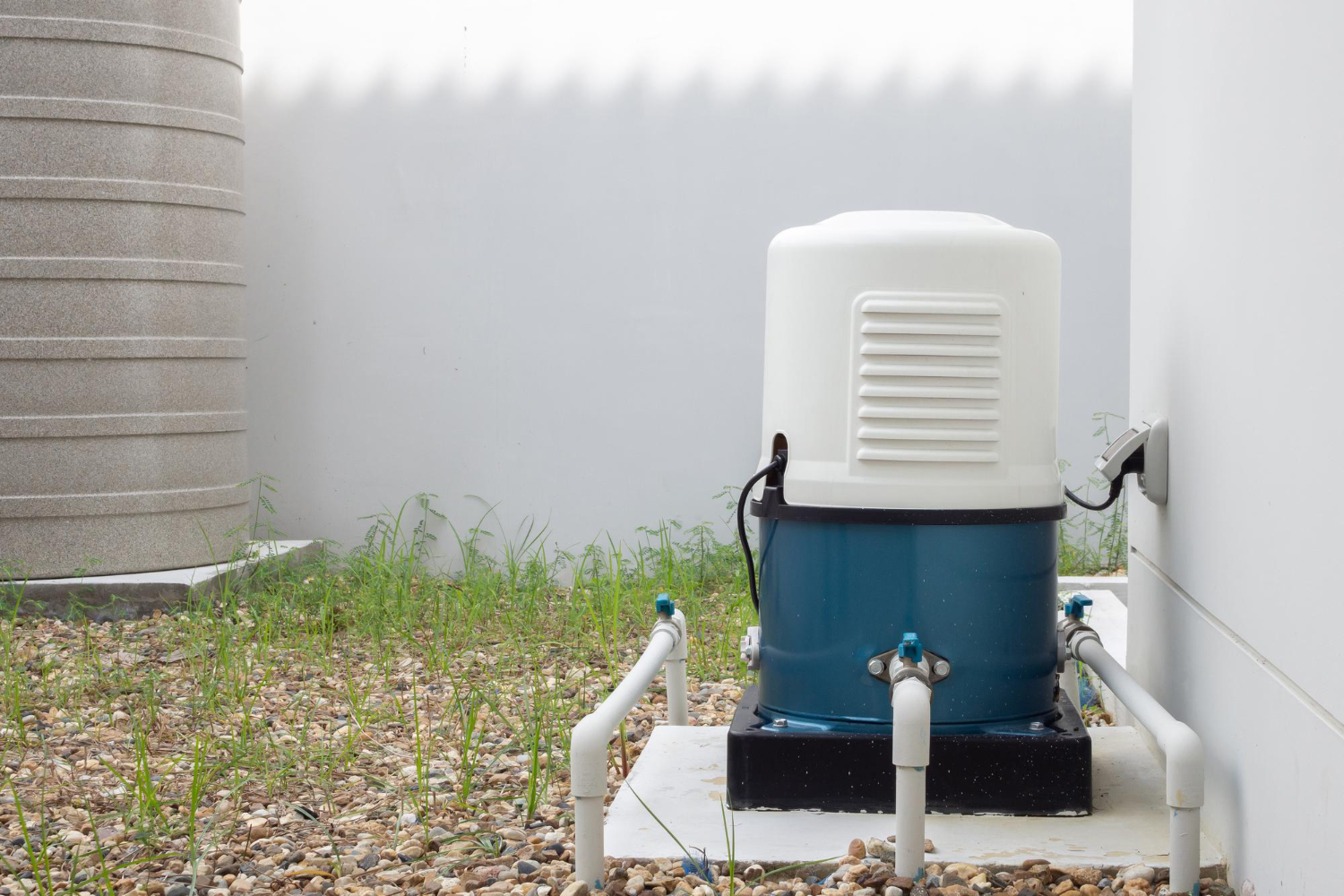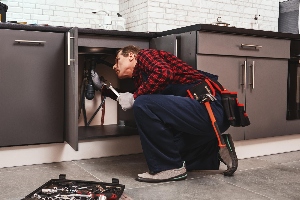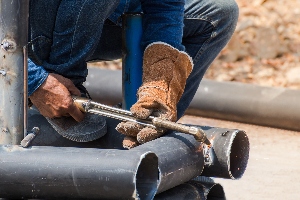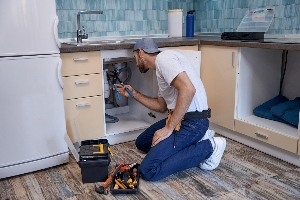When power outages strike during storms, your main sump pump stops working just when you need it most. Water-powered sump pumps can run without electricity by using your home's water pressure instead of electrical power. This backup system automatically kicks in when water levels rise too high in your sump pit.
These pumps work by connecting to your home's water supply line and using the pressure to create suction that removes water from your basement. We'll explore how these systems operate during emergencies and when they make sense as a backup solution for your home.
Understanding the mechanics behind water-powered pumps helps you make informed decisions about basement flooding protection. In this article, you’ll learn how water powered sump pumps protect your basement during power outages without relying on electricity.
Below, we’ll walk through each important aspect:
- What is a water-powered sump pump?
- When to consider a sump pump with backup
- How water powered sump pumps work in emergencies
- Choosing the right water driven backup sump pump
- Long-term reliability and maintenance
Keep reading to learn how to choose the right system and what maintenance requirements you can expect over time.
What is a water-powered sump pump?
A water-powered sump pump is a backup system that uses municipal water pressure to remove flood water from your basement without needing electricity or batteries. These pumps work through the venturi effect, creating suction that moves water out of the sump pit using your home's water supply.
The basic mechanics of water-driven backup systems
Water-powered sump pumps operate using a simple but effective principle called the venturi effect. When municipal water flows through a narrow section inside the pump, it creates a vacuum that pulls water from the sump pit.
According to the City of Midland’s advisory, water-driven sump pumps operate with a 1:2 ratio—using one gallon of city water to eject two gallons of sump pit water. This efficiency is based on typical municipal pressure ranges and assumes ideal conditions for venturi-based systems.
The system connects directly to your home's water supply line. As city water flows through the pump's venturi chamber, it creates suction that draws flood water up through an intake pipe.
Key components include:
- Water supply connection
- Venturi chamber
- Intake pipe
- Discharge pipe
- Flow control valve
The pump automatically activates when water levels rise in the sump pit. No electricity or manual operation is needed. As long as municipal water pressure remains available, the system continues working even during power outages.
The SSPMA guide on backup sump pumps highlights that for effective operation, water-powered units should have a sustained pressure of at least 40 PSI. Lower pressures may significantly reduce flow rates and compromise flood protection during peak demand periods.
Most water-powered pumps can remove 2-3 gallons of basement water for every gallon of city water used. This ratio makes them effective for handling typical basement flooding situations.
Comparing water backup sump pumps to electric models
Water-powered sump pumps work differently than electric models in several important ways. Electric pumps use motors to power impellers that move water, while water-powered systems rely on water pressure and physics.
Performance differences:
Feature
Water-Powered
Electric
Power source
Municipal water
Electricity
Pumping speed
Slower
Faster
Power outage operation
Yes
No
Maintenance needs
Minimal
Regular
Electric models typically pump water much faster than water-powered systems. However, they stop working immediately when power fails. Water-powered pumps continue operating as long as city water pressure remains available.
Water-powered systems have fewer moving parts compared to electric pumps. This means less maintenance and fewer potential failure points. Electric pumps require motor maintenance, impeller cleaning, and regular testing.
Benefits of using municipal water for pump operation
Municipal water systems provide several advantages for powering backup sump pumps. City water pressure typically remains stable during storms when electrical power often fails.
Primary benefits include:
- No battery replacement costs - Electric backup pumps need battery changes every 3-5 years
- Unlimited runtime - Works as long as city water flows
- No power dependency - Functions during extended outages
- Low maintenance - Few moving parts to service
Municipal water pressure usually stays consistent between 40-80 PSI. This pressure range provides enough force to operate the venturi system effectively. The steady water supply means the pump can run continuously if needed.
We don't need to worry about battery life or charging systems. The pump draws power directly from water pressure that utilities maintain even during emergencies.
However, homes with well water cannot use these systems effectively. Wells lose pressure during power outages, making water-powered pumps useless when you need them most.
When to consider a sump pump with backup
We recommend backup sump pumps for homes with frequent power outages or those in flood-prone areas. Water-powered backups work when electricity fails, using municipal water pressure to remove basement water.
Power outage risks and basement flooding
Power outages create the worst timing for sump pump failures. Storms that cause flooding often knock out electricity at the same time.
Common power outage scenarios include:
- Severe thunderstorms with heavy rain
- Ice storms that down power lines
- Equipment failures during peak usage
- Planned utility maintenance
Without backup power, our primary sump pump stops working. Water continues entering the basement through foundation cracks and drainage systems. This creates a perfect storm for basement flooding.
Most standard sump pumps need electricity to operate. When power fails, water levels rise quickly in the sump pit. We have only hours before water overflows into our basement.
Battery backups typically run 4-6 hours on a full charge. Water-powered backups work as long as municipal water pressure remains available. This makes them more reliable during extended outages.
Homes that benefit most from water powered backups
Certain homes face higher basement flooding risks and need backup systems. We should consider water-powered backups in these situations.
High-risk homes include:
- Properties in flood zones
- Basements below the water table
- Areas with frequent power outages
- Homes with finished basements
Houses with municipal water connections work best with water-powered backups. These systems need steady water pressure to create the siphon effect. Rural homes with well water may not have enough pressure.
Finished basements with expensive flooring, furniture, or electronics need reliable protection. Water damage repairs cost thousands of dollars. A backup system prevents costly flooding damage.
Areas with aging electrical infrastructure experience more power outages. We see this in older neighborhoods during storms. Water-powered backups provide protection when the grid fails repeatedly.
Signs your current sump pump setup needs a backup
Several warning signs indicate our current sump pump setup needs backup protection. We should watch for these red flags.
Key warning signs:
- Frequent power outages in our area
- Water marks on basement walls
- Musty odors suggesting previous moisture
- Single pump handling all drainage
Our current pump struggles during heavy rain if it runs constantly. This overworks the motor and increases failure risk. A backup system provides extra capacity when needed.
Previous basement flooding indicates our setup cannot handle extreme conditions. Even minor water intrusion shows vulnerability. We need backup protection before major flooding occurs.
Old sump pumps fail more often and need replacement parts. Adding a backup system protects us while we plan pump upgrades. This prevents emergency situations during storms.
How water powered sump pumps work in emergencies
Water-powered sump pumps use municipal water pressure to create suction that removes water from basements during power outages. These systems face specific challenges during severe weather events when both electricity and water pressure may be affected.
How suction and pressure power the pump
Water-powered sump pumps rely on the Venturi effect to create suction. Municipal water flows through a narrow section inside the pump unit at high speed.
This fast-moving water creates a vacuum that pulls water from the sump pit. The system needs consistent water pressure of at least 20 PSI to work properly.
When water enters the pump from your home's supply line, it passes through a specially designed nozzle. This creates the suction force needed to lift water from the basement.
The pump connects directly to your municipal water line. It uses about 1 gallon of city water to remove 2 gallons from your sump pit.
Key components include:
- Water supply connection
- Venturi nozzle system
- Discharge pipe
- Check valve
What happens during heavy storms or blackouts
During blackouts, water-powered pumps continue working as long as municipal water pressure remains stable. We see this advantage during storms when electrical power fails but water systems stay online.
Heavy storms can affect pump performance in several ways. High water tables may reduce the suction efficiency of the system.
Municipal water systems sometimes experience pressure drops during emergencies. When pressure falls below 20 PSI, the pump loses effectiveness.
Power outages lasting 4-6 hours often leave battery backup systems drained. Water-powered pumps can run indefinitely during these extended outages.
Storm-related water main breaks will shut down water-powered systems completely. This makes them less reliable than battery backups in some emergency situations.
Limitations to be aware of with water-based systems
Water-powered pumps pump slower than electric models. They typically move 1,000-1,500 gallons per hour compared to 3,000+ gallons for electric pumps.
Major limitations include:
Limitation
Impact
Water pressure dependency
No backup if municipal pressure fails
Slower pumping rate
May not keep up with heavy flooding
Continuous water use
Higher water bills during operation
Installation requirements
Needs proper water line connection
These systems work best as secondary backup options rather than primary flood protection. We recommend them for areas with reliable municipal water systems.
Water-based systems cannot work in homes with well water unless you have a pressure tank system. The pump also adds minerals and debris to your water bill during each use.
Choosing the right water driven backup sump pump
Water-powered backup sump pumps need specific performance requirements and proper installation to work effectively. The right pump depends on your home's water pressure, pumping needs, and installation setup.
Performance factors to evaluate before buying
We need to check several key performance factors before buying a water-powered sump pump. Water pressure is the most important factor since these pumps rely on municipal water pressure to operate.
Your home needs at least 20 PSI of water pressure for basic operation. Most water-powered pumps work best with 40-80 PSI. We recommend testing your water pressure during peak usage times when pressure drops.
Pumping capacity varies by model and water pressure. Higher water pressure creates more pumping power. Most water-powered pumps can handle 1,000-2,000 gallons per hour at normal pressure levels.
The pump's activation system should respond quickly to rising water levels. Look for pumps with reliable float switches or water level sensors.
Durability matters since backup pumps may sit unused for months. Choose pumps made from corrosion-resistant materials like stainless steel or heavy-duty plastic.
Installation tips and water pressure requirements
Water-powered sump pumps need connection to your home's water supply line. We must install a pressure tank or use direct connection to the main water line.
Water pressure testing should happen before installation. Use a pressure gauge to measure PSI at different times of day. Peak usage hours often show lower pressure readings.
The installation requires a water supply line connection and a discharge line for pumped water. We need to install the water supply line above the pump to prevent back-siphoning.
Drain line sizing affects performance. Most pumps need 1.5-inch or 2-inch discharge pipes. Smaller pipes reduce pumping efficiency.
The pump must sit level in the sump pit. We should secure it to prevent movement during operation. Check local plumbing codes for installation requirements.
Why professional installation matters for reliability
Professional installation ensures water-powered sump pumps work correctly when needed. We recommend hiring licensed plumbers who understand local codes and proper installation methods.
Water line connections require plumbing expertise. Incorrect connections can cause water damage or pump failure. Professionals know how to connect to water supply lines safely.
Pressure regulation may need adjustment for optimal performance. Plumbers can install pressure regulators if your water pressure is too high or too low.
Code compliance varies by location. Professional installers understand local building codes and permit requirements. They ensure installations meet safety standards.
Testing and maintenance setup is crucial for reliability. Professionals can show you how to test the system and schedule regular maintenance checks.
Long-term reliability and maintenance
Water-powered backup sump pumps need regular upkeep to work properly over their expected lifespan. While some manufacturers claim these systems are maintenance-free, we must address common issues that can affect their performance.
Lifespan of a water powered backup sump pump
Water-powered sump pumps typically last 8 to 15 years with proper maintenance. Their lifespan depends on several key factors.
Water quality plays a major role in how long these pumps last. Hard water with high mineral content can cause buildup inside the pump components. This reduces efficiency over time.
Factors affecting lifespan:
- Water hardness levels
- Frequency of use during flooding
- Quality of installation
- Regular maintenance schedule
The Venturi valve is the most critical component. It creates the suction needed to pump water out. This part may need replacement every 5 to 7 years depending on water conditions.
Municipal water pressure also affects pump life. Systems work best with water pressure between 20 and 100 PSI. Low pressure reduces pumping capacity and can cause premature wear.
Regular maintenance vs. set-it-and-forget-it claims
Many manufacturers market water-powered pumps as set-it-and-forget-it systems. This claim is misleading and can lead to pump failure when you need it most.
We recommend checking your pump every 3 months. Test the system by pouring water into the sump pit. The pump should activate automatically when water reaches the trigger level.
Essential maintenance tasks:
- Clean debris from intake screen
- Check water supply connections
- Test pump activation
- Inspect discharge line for clogs
The intake screen collects sediment and debris over time. A clogged screen reduces water flow and pump efficiency. Clean it with a soft brush and water.
Water supply connections can loosen due to vibration. Check all fittings for leaks or loose connections. Tighten as needed but avoid over-tightening.
Troubleshooting low performance or failure
Low pumping performance usually indicates specific problems we can identify and fix. The most common issue is reduced water pressure from the municipal supply.
Common performance problems:
- Weak water pressure (below 20 PSI)
- Clogged Venturi valve
- Blocked discharge line
- Damaged intake screen
If the pump runs but moves little water, check the discharge line first. Ice, debris, or a stuck check valve can block water flow. Clear any obstructions you find.
The Venturi valve may need cleaning if performance drops gradually. Mineral deposits can narrow the opening and reduce suction power. Some valves can be cleaned while others need replacement.
Water pressure problems require professional help. Low municipal pressure affects the entire system. Contact your water utility if pressure drops below normal levels.
Test your pump before storm season starts. Pour water into the pit and time how long it takes to empty. Compare this to the manufacturer's specifications for your model.
Conclusion
Water-powered sump pumps offer a reliable backup solution when electricity fails. They use your home's water pressure to remove water from basements and crawl spaces.
These pumps work best in homes with good water pressure. City water systems typically provide the 20-40 PSI needed for proper operation.
Water-powered pumps do have limitations. They pump water slower than electric models. They also increase your water bill since they use city water to operate.
We recommend these pumps as backup systems rather than primary pumps. They work well with battery backup pumps for complete protection.
Installation requires basic plumbing skills. Most homeowners can install them in 1-2 hours with simple tools.
Regular maintenance involves checking connections and testing operation. Clean the pump every few months to prevent clogs.
Water-powered sump pumps cost more to operate than electric pumps. However, they provide peace of mind during storms and power outages.
These pumps suit homes in flood-prone areas or places with frequent power outages. They give homeowners an extra layer of protection against water damage.
Consider your home's water pressure and local water costs before buying. Talk to a plumber if you're unsure about installation or compatibility.
Contact our licensed plumbers today to install a water powered sump pump that keeps your basement protected, no electricity required.












